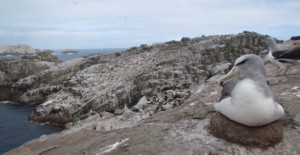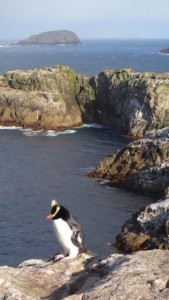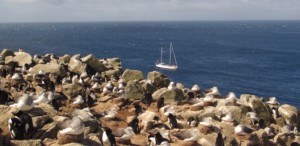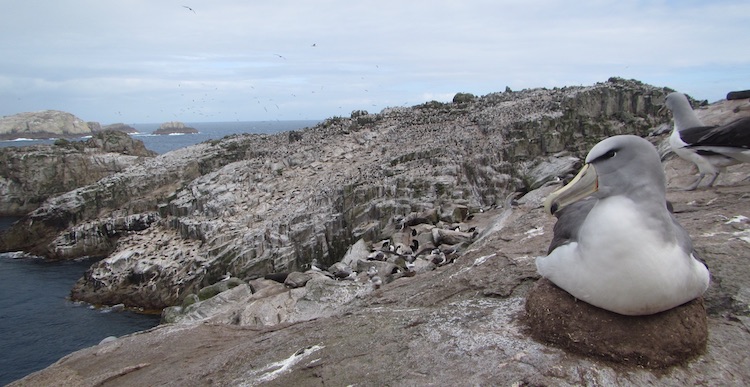I’m standing on a giant bare rock, in what feels like the middle of the ocean, surrounded by around 2,000 albatross and 3,000 pairs of penguins. The sky is a vivid blue, and the sea down below sparkles so bright it is breathe-taking.
This enormous rock island that juts out of the sea, about 900 km south east of the southern tip of New Zealand, is part of an assemblage called the Bounty Islands – so named after the ship, the Bounty (famous for her mutiny). The island rock I find myself on is called Proclamation Island, I assume for being the first “proclaimed” island of the group when the British landed and claimed it for the then King of England in 1930. It stands a giant 73 m high, and is home to Erect-crested Penguins, Salvin’s Albatrosses, Fulmar Prions, Pintado Petrels, Bounty Shags and Antarctic Fur Seals. The Bounty Islands rise up out of the ocean, bare, with sheer cliffs and rough sea swells. They sound desolate but the life that they harbour and cultivate is breathtaking. Seabirds and seals alike make their way to these harsh barren islands each year for the breeding season and in so doing, turn the Bounties into a hubbub of life – like a warmly lit crowded pub on a cold grey night.

I’m helping conduct a census of the breeding birds on the island, and in doing so, at this moment need to navigate my way between a magnificent male seal, who is really not keen on me invading his harem, and seabirds equally unhappy at my encroachment on their own tiny spaces that they have fought hard for to claim for their nests. Every little patch, nook and cranny of the island is accounted for by some animal who has to continually fight to maintain their claim on what available area they have eked out for themselves. It’s unlike any other breeding colony I’ve seen before, the albatross and penguins are all mixed in together in this jostle of life and the seals use up the smooth round boulders where the birds can’t lay their eggs.
As there is no soil or vegetation for the birds to make their nests out of the animals have had to get creative to call this place “home”. Albatrosses make use of the mud pools in between the rocks and boulders (made up of rain water, sea spray, decaying matter and faeces) to build their nest mounds. The shags collect and bring back seaweed and plant matter from the ocean. Penguins carry their eggs on their feet and prions lay their eggs straight on to the hard rock.

I have the privilege of seeing these feisty and wonderful Erect-crested Penguins up close as during my BOU-funded PhD my aim is to track them, and other Eudyptes penguin species, using geolocation devices, so that we may gain insight into where they go and what they do during their winter migrations. The migrations of the Eudyptes penguins last around five months and are spent entirely out at sea- and it is during this time in their lives that we have very little knowledge of where they go and what they do. In fact, of all the penguin species, Erect-crested Penguins are the least studied in the world and listed as endangered on the IUCN’s Red List. They are endemic to the New Zealand sub-Antarctic region, breeding only on the Bounty Islands and Antipodes Islands. My PhD project follows in the footsteps of John Warham – the grandfather of Eudyptes penguin research – and of course, the gentleman, along with his wife Pat, who so kindly made it possible for fledgling researchers like myself to study seabirds as a BOU Warham-funded student.
So, raise a glass to John Warham the next time you wonder about the life of a penguin, and I’ll raise my foot and step boldly forth on Proclamation Island as I gather data to answer the questions asked by John all those years ago when he stood as a budding young scientist with burning interest of the lives of our little flippered friends.

The team on this Bounty Islands expedition consisted of six field biologists and six crew members, who sailed aboard the yacht Evohe (above) down to the sub-Antarctic islands. There are no structures on Proclamation Island, the field team stayed on the yacht and went ashore the island daily to conduct the research which took place over five days, in October 2019.
This project is supervised by Prof Mark Hindell and will be run in conjunction with the British Antarctic Survey and New Zealand National Institute for Water and Atmospheric Research.
BOU John & Pat Warham Studentships are funded by a bequest left to the BOU by the late John and Pat Warham for the study of of Sphenisciform and Procellariiform seabirds by students from Commonwealth countries. Four fully-funded studentships will be awarded with one studentship awarded per year from 2018.
Image Credits
All images © Paige Green.




